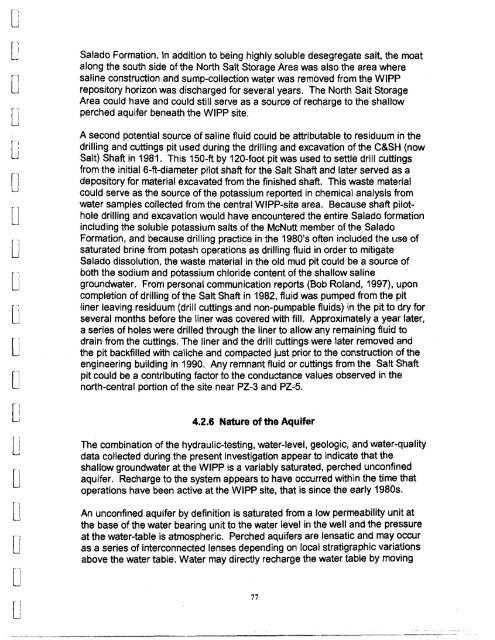o - Waste Isolation Pilot Plant
o - Waste Isolation Pilot Plant
o - Waste Isolation Pilot Plant
Create successful ePaper yourself
Turn your PDF publications into a flip-book with our unique Google optimized e-Paper software.
u<br />
o<br />
[J<br />
[J<br />
[]<br />
D<br />
D<br />
u<br />
LJ<br />
u<br />
u<br />
[]<br />
u<br />
[]<br />
U<br />
[:<br />
[]<br />
rJ<br />
Salado Formation. In addition to being highly soluble desegregate salt, the moat<br />
along the south side of the North Salt Storage Area was also the area where<br />
saline construction and sump-collection water was removed from the WIPP<br />
repository horizon was discharged for several years. The North Salt Storage<br />
Area could have and could still serve as a source of recharge to the shallow<br />
perched aquifer beneath the WIPP site.<br />
A second potential source of saline fluid could be attributable to residuum in the<br />
drilling and cuttings pit used during the drilling and excavation of the C&SH (now<br />
Salt) Shaft in 1981. This 150-ft by 120-foot pit was used to settle drill cuttings<br />
from the initial 6-ft-diameter pilot shaft for the Salt Shaft and later served as a<br />
depository for material excavated from the finished shaft. This waste material<br />
could serve as the source of the potassium reported in chemical analysis from<br />
water samples collected from the central WIPP-site area. Because shaft pilothole<br />
drilling and excavation would have encountered the entire Salado formation<br />
including the soluble potassium salts of the McNutt member of the Salado<br />
Formation, and because drilling practice in the 1980's often included the use of<br />
saturated brine from potash operations as drilling fluid in order to mitigate<br />
Salado dissolution, the waste material in the old mud pit could be a source of<br />
both the sodium and potassium chloride content of the shallow saline<br />
groundwater. From personal communication reports (Bob Roland, 1997), upon<br />
completion of drilling of the Salt Shaft in 1982, fluid was pumped from the pit<br />
liner leaving residuum (drill cuttings and non-pumpable fluids) in the pit to dry for<br />
several months before the liner was covered with fill. Approximately a year later,<br />
a series of holes were drilled through the liner to allow any remaining fluid to<br />
drain from the cuttings. The liner and the drill cuttings were later removed and<br />
the pit backfilled with caliche and compacted just prior to the construction of the<br />
engineering bUilding in 1990. Any remnant fluid or cuttings from the Salt Shaft<br />
pit could be a contributing factor to the conductance values observed in the<br />
north-central portion ofthe site near PZ-3 and PZ-5.<br />
4.2.6 Nature of the Aquifer<br />
The combination of the hydraulic-testing, water-level, geologic, and water-quality<br />
data collected during the present investigation appear to indicate that the<br />
shallow groundwater at the WIPP is a variably saturated, perched unconfined<br />
aquifer. Recharge to the system appears to have occurred within the time that<br />
operations have been active at the WIPP site, that is since the early 1980s.<br />
An unconfined aquifer by definition is saturated from a low permeability unit at<br />
the base of the water bearing unit to the water level in the well and the pressure<br />
at the water-table is atmospheric. Perched aquifers are lensatic and may occur<br />
as a series of interconnected lenses depending on local stratigraphic variations<br />
above the water table. Water may directly recharge the water table by moving<br />
77<br />
._------'---,...

















